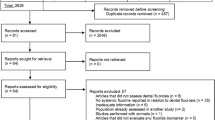Abstract
Dental fluorosis had been used for deriving the fluoride acceptable threshold for a long time. However, it was diagnosed on the color or defect degree of tooth, like Dean’s Index, which would be easily influenced by lifestyle, like smoking and drinking tea. Hence, some biomarkers had already tried to assess the fluoride exposure risk with the development of bio-monitor technique, and this paper probed on an available biomarker, which based on a systematic biochemical indicator group relating to different biological function from animal experiment, to take place the old one. The experiment animals had been treated with different levels of NaF, and biochemical indicators were analyzed after three months later. The correlations between changes of biochemical indicators and the exposure levels were analyzed subsequently, and a comprehensive indicator was developed. Both the NOAEL/LOAEL and the Benchmark Dose approach were applied in this article to derive the suitable threshold and for indicator comparison. Our findings indicated that a better dose-response relationship was shown between the comprehensive indicator and exposure dose (R=0.811, R square=0.657) than single indicator (R<0.4, R square<0.2) and Dean’s Index (R=0.737, R square= 0.543). Furthermore, the available threshold of the comprehensive indicator was 1.70 mg/(kg.d) lower than it from dental fluorosis (2.00 mg/(kg.d)) which can protect animals from fluoride damage at rather low exposure level. Even the scientificity of the comprehensive indicator should be verified in further epidemiology research, its advantage can’t be ignored that it cannot only avoid the personally error during clinical diagnosis, but also present a new method to quantize the gap risk from dental fluorosis to skeletal fluorosis for those people cannot be diagnosed by dental fluorosis clinically.
Similar content being viewed by others
References
Olivier, B. et al. Molecular mechanisms of fluoride toxicity. Chem. Biol. Interact. 188, 319–333 (2010).
WHO. Fluoride in Drinking-water: Background document for development of WHO Guidelines for Drinking-water Quality. World Health Organization 2 (2004).
Gabriel, T. F. C. et al. A Review of the Uses of Fluoride and Outcomes of Dental Caries Control in Singapore. Singa. Dent. J. 32, 14–18 (2011).
Wu, R. et al. Modeling Contaminant Concentration Distributions in China’s Centralized Source Waters. Environ. Sci. Technol. 45, 6041–6049 (2011).
Amini, M. et al. Environ. Statistical Modeling of Global Geogenic Fluoride Contamination in Groundwaters. Environ. Sci. Technol. 42, 3662–3668 (2008).
Abhishek, M. Biomarkers of fluoride exposure in human body. Indian J. Dentistry 4, 207–210 (2013).
US EPA. The use of the benchmark dose approach in health risk assessment epa/630/r-94/007 (1995).
Maiko, S. et al. Sirtuin1 and autophagy protect cells from fluoride-induced cell stress. Bba-Mol. Basis. Dis. 1842, 245–255 (2014).
Wei, W. et al. Excessive Fluoride Induces Endoplasmic Reticulum Stress and Interferes Enamel Proteinases Secretion. Environ. Toxicol. 28, 332–341 (2013).
Bergandi, L. et al. The toxic effect of fluoride on MG-63 osteoblast cells is also dependent on the production of nitric oxide. Chemico-biological Interact. 90, 179–186 (2011).
St-Arnaud, R. et al. Combinatorial control of ATF4-dependent gene transcription in osteoblasts. Ann. NY. Acad. Sci. 1237, 11–18 (2011).
Yang, X. et al. ATF4 is a substrate of RSK2 and an essential regulator of osteoblast biology; implication for Coffin-Lowry Syndrome. Cell 117, 387–398 (2004).
Karube, H. et al. NaF activates MAPKs and induces apoptosis in odontoblast-like cells. J. Dent. Res. 88, 461–465 (2009).
Liu, L. et al. The effects of free radicals, oxidative stress and ultrastructure of fluoride on rats. China’s Public Health 25, 1114–1115 (2009).
He, H. et al. Study on Changes of Clinical Indicators and Key Proteins from Fluoride Exposure. Biol. Trace. Elem. Res. 161, 73–78 (2014).
He, H. et al. Rat liver function and biochemical indexes changes from Fluoride Exposure. Occup. Health 30, 2571–2573 (2014).
Chen, S. et al. Change of urinary fluoride and bone metabolism indicators in the endemic fluorosis areas of southern china after supplying low fluoride public water. Bmc Public Health 13, 1–10 (2013).
Song, Y. E. et al. Effect of fluoride exposure on bone metabolism indicators ALP, BALP, and BGP. Environ. Health Prev. Med. 16, 158–163 (2011).
Bharti, V. K. et al. Effects of melatonin and epiphyseal proteins on fluoride-induced adverse changes in antioxidant status of heart, liver, and kidney of rats. Adv. Pharmacol. Sci. 2014, 532969–532969 (2014).
US EPA. The use of the beanchmark dose approach in health risk assessment (1995).
Harvey, J. C. et al. Investigation of the potential impact of benchmark dose and pharmacokinetic modeling in noncancer risk assessment. J. Toxicol. Environ. Health. 52, 475–515 (1997).
US EPA. Benchmark Dose Technical Guidance. EPA/100/R-12/001 (2012).
Everett, E. T. et al. Fluoride’s effects on the formation of teeth and bones, and the influence of genetics. J. Dental Res. 90, 552–560 (2011).
Danko, S. J. et al. The Use of Metal Fluoride Compounds as Phosphate Analogs for Understanding the Structural Mechanism in P-type ATPases. Methods Mol. Biol. 1377, 195–209 (2016).
Lars, A. J. et al. Model selection of copulas: AIC versus a cross validation copula information criterion. Stat. Prob. Lett. 92, 249–255 (2014).
Author information
Authors and Affiliations
Corresponding author
Rights and permissions
About this article
Cite this article
Zhou, Z., Zheng, B., Wang, H. et al. Probe on the biomarker to substitute the dental fluorosis for deriving fluoride threshold by animal study. Toxicol. Environ. Health Sci. 8, 79–85 (2016). https://doi.org/10.1007/s13530-016-0264-2
Received:
Revised:
Accepted:
Published:
Issue Date:
DOI: https://doi.org/10.1007/s13530-016-0264-2




